William I |
Edward II |
||
William II |
Henry VIII |
||
Henry I |
Edward VI |
Anne |
|
Henry IV |
George I |
||
George II |
|||
Richard I |
|||
Edward IV |
|||
Edward V |
Cromwell |
William IV |
|
Richard III |
|||
Charles 1st, 1625 - 1649
Charles 1st is probably most famous for losing his head. A very high-minded individual, he made many serious mistakes; some due to the influence of his thoroughly-disliked (and, unfortunately, Catholic) wife, Henrietta of France, and some due to his own inability to see the likely results of his own actions. He inherited his father's financial problems and was thus plunged into a lifelong battle with Parliament over taxes. He declared war on Parliamentary forces in 1642 and was eventually captured and then beheaded - for treason - in 1649. |
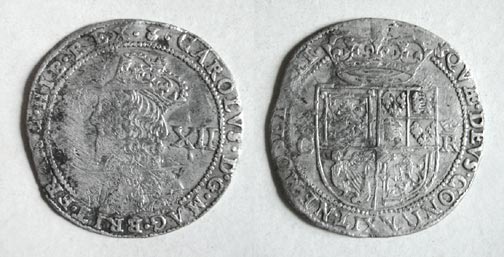
Scottish 12 shilling piece This is the largest silver hammered coin I have found so far, measuring 33 mm across. It must have taken quite a whack to make these... While valued at 12-shillings in Scotland, it was only valued at 1 shilling in England. It was minted sometime between 1624 and 1642. |
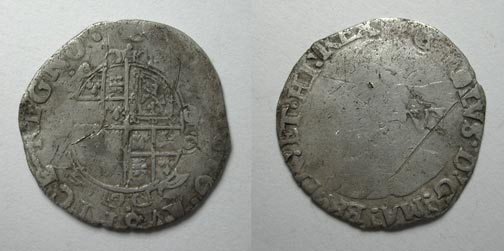
Sixpence Truly, a 'hammered' hammered... Spink no. 2800 |
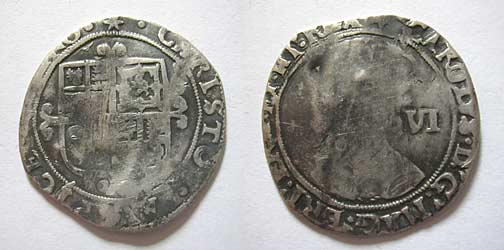
Sixpence Spink no. 2846 or 2847. |
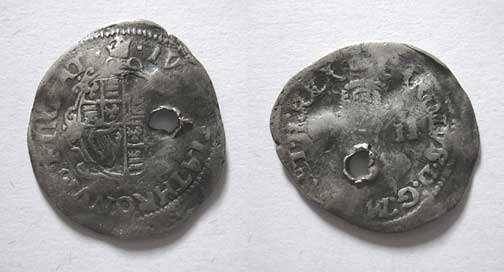
Half-groat I have now heard three different but plausible explanations for the hole in this coin. They could all be true - take your pick: 1) Parliament, when it finally took control of the country, issued its own coinage - but could not mint them fast enough to satisfy demand. Faced with a chronic currency shortage it was forced to re-issue Charles 1st coins that had already been withdrawn from circlulation, but defaced them first - hence the hole in this one. 2) In 1696, in order to raise tax revenue, a 'Window Tax' was created, replacing the previous 'hearth tax'. The Hearth Tax had proved very unpopular, as it was the first time that tax collectors were given the right to actually enter a property in order to count the hearths. However, it did not raise enough money - partly because collection was farmed out to private individuals who invariably took their cut. So, windows were taxed instead. This was deemed a more fair tax, as the bigger your house, the more windows - and the richer you must surely be. In response, many property owners bricked-up windows in protest, and these can still be seen on many buildings dating from the period. As money from the tax rolled in, much of it in the form of older hammered coins, those which were deemed badly clipped or worn were removed from circulation. Those which were still in good shape were pierced and put back in circulation. 3) Again in 1696, a major re-coinage was undertaken specifically intended to replace the hammered coins still in circulation. After a short period in which the use of unclipped hammered coins was allowed to continue - provided they had been officially pierced in the centre - they were finally demonetized. Regardless of which of the above is true, this coin is Spink no. 2818. It is also my second-ever hammered coin. |
Back to top
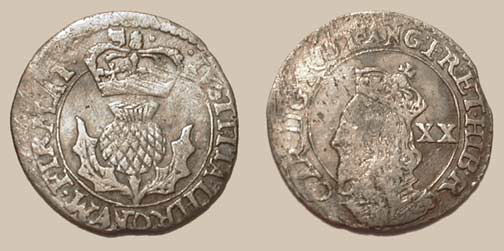
Scottish 20 pence A very nice little coin, about the same size as an English half-groat, and thus valued at around 2 pence, south of the border. |
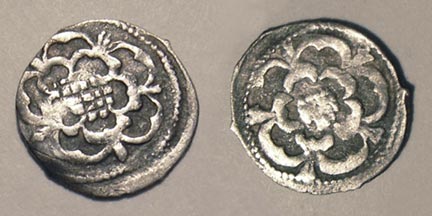
Halfpenny Made at the Tower (of London) Mint while it was still under the control of the King, between 1624 and 1642. This is the smallest coin I have ever found, at only 9mm wide. They must have been very difficult to handle. Spink no. 2837 |
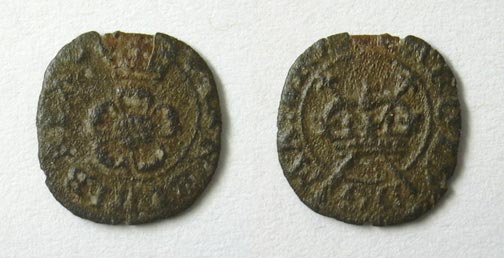
'Rose' farthing Charles was only the second British monarch to issue copper coins. Small change, quite literally: it's only 12mm wide. They, like the halfpenny (above), must also have been very easy to lose. Spink no. 3204. |
Back to top
Home |
Collection |
Cartoons |
Stories |